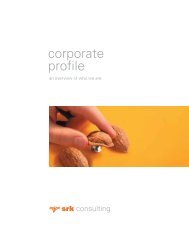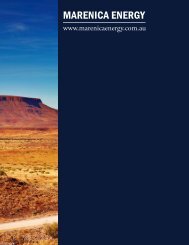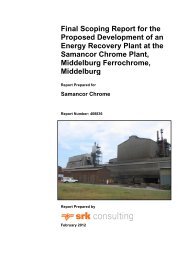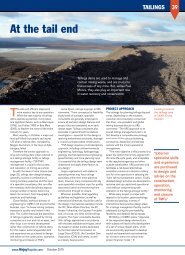Draft Status Quo Report for the Pixley Ka Seme ... - SRK Consulting
Draft Status Quo Report for the Pixley Ka Seme ... - SRK Consulting
Draft Status Quo Report for the Pixley Ka Seme ... - SRK Consulting
Create successful ePaper yourself
Turn your PDF publications into a flip-book with our unique Google optimized e-Paper software.
<strong>SRK</strong> <strong>Consulting</strong> in association with BKS<br />
<strong>Pixley</strong> <strong>Ka</strong> <strong>Seme</strong> Local Municipality EMF – <strong>Draft</strong> <strong>Status</strong> <strong>Quo</strong> <strong>Report</strong> Page 30<br />
intensively grazed. There is a medium-level need to<br />
protect smaller localised patches of grassland associated<br />
with wetlands.<br />
The Eastern Plains Grassland is considered to be<br />
Endangered / Vulnerable, due to extensive potential<br />
<strong>for</strong>estry and mining. Only a small part of this vegetation<br />
type occurs within <strong>the</strong> study area. There are currently<br />
applications <strong>for</strong> more mining in this vegetation type,<br />
within <strong>the</strong> study area. Consequently, <strong>the</strong> need <strong>for</strong><br />
protection is high.<br />
The mountainous, steeper and rocky areas of <strong>the</strong><br />
Escarpment Grassland and Mountain Grassland, as well<br />
as <strong>the</strong> Forests, are not really threatened due to less<br />
development on <strong>the</strong>se mountains. Due to <strong>the</strong><br />
ruggedness, <strong>the</strong>se areas are also best protected against<br />
development and habitation and <strong>the</strong> conservation status<br />
is <strong>the</strong>re<strong>for</strong>e Least Threatened. Although <strong>the</strong> threats are<br />
relatively small, <strong>the</strong> exceptional biodiversity and scenic<br />
beauty imply a high need <strong>for</strong> statuary protection.<br />
Threatened and endangered plant species<br />
The south-eastern parts of <strong>the</strong> study area are <strong>the</strong> most<br />
important as a hotspot area <strong>for</strong> Red Data taxa (see Map<br />
24). This area mainly includes Mountain Grassland and<br />
Escarpment Grassland as well as <strong>the</strong> Wakkerstroom<br />
Wetland area.<br />
Alien plants<br />
Alien vegetation, mainly black wattle, is prevalent in<br />
<strong>the</strong> sou<strong>the</strong>rn and eastern portions of <strong>the</strong> PKSLM. Alien<br />
invasive vegetation in <strong>the</strong> upper Buffalo River<br />
Catchment, and upper Vaal Catchment, are estimated to<br />
reduce <strong>the</strong> mean annual runoff (MAR) by 3.9 and 3.8 %<br />
respectively (Versveld et al., 1998). Alien vegetation<br />
also displaces indigenous species, and leads to a<br />
reduction in biodiversity. Fur<strong>the</strong>rmore, rooting systems<br />
of many alien plant species, such as black wattle, tend<br />
to be shallow and this makes stream banks that are<br />
colonised by such plants vulnerable to erosion.<br />
Fauna<br />
Mammals<br />
Threatened and endangered mammal species<br />
distribution was obtained from <strong>the</strong> Mpumalanga<br />
Tourism and Parks Agency (MTPA). The PKSLM area<br />
contains 76 species of mammals, which excludes<br />
animals found in <strong>the</strong> nature reserves or game farms.<br />
Red Data listed mammal species include 12 species.<br />
These include species such as Ourebia oribi (Oribi) and<br />
possibly Poecilogale albinucha (African Weasel), Lutra<br />
maculicollis (Spotted-necked Otter) as well as shrew<br />
species of <strong>the</strong> genera Crocidura and Myosorex.<br />
Birds<br />
According to <strong>the</strong> MTPA database 17 Red Data listed<br />
bird species have been recorded from <strong>the</strong> study area.<br />
Some of <strong>the</strong>se species are rare and protection of<br />
grasslands and wetlands is critical <strong>for</strong> <strong>the</strong>ir survival.<br />
Important Birding Areas are found almost throughout<br />
<strong>the</strong> entire municipality (see Map 27).<br />
Fish<br />
A number of fish species that are sensitive to water<br />
quality deterioration are expected to occur within <strong>the</strong><br />
PKSLM. These are located mainly in <strong>the</strong> Usutu<br />
Catchment, and less so in <strong>the</strong> Thukela River Catchment.<br />
There are no highly sensitive fish species in <strong>the</strong> upper<br />
Vaal River Catchment.<br />
Alien fish species identified in <strong>the</strong> study area include<br />
trout, bass, grass carp and common carp, all of which<br />
tend to have a negative impact on indigenous fish<br />
species diversity. Grass carp were introduced into<br />
Heyshope Dam, so <strong>the</strong>re is a possibility that <strong>the</strong>y may<br />
move into <strong>the</strong> tributaries upstream of <strong>the</strong> dam<br />
(Engelbrecht and Roux, 2008).<br />
Reptiles<br />
Sixty species of reptiles (snakes, lizards, geckos,<br />
tortoises) have been recorded in <strong>the</strong> study area, eight of<br />
<strong>the</strong>se being possible Red Data species.<br />
Amphibians<br />
Twenty-two frog species occur in <strong>the</strong> PKSLM.<br />
Although <strong>the</strong> MTPA data indicates Heleophryne<br />
natalensis (=Hadromophryne natalensis) and<br />
Vandijkophrynus gariepensis as Red Data listed frog<br />
species, nei<strong>the</strong>r are currently listed as Threatened.<br />
Invertebrates<br />
Data on threatened and endangered invertebrate species<br />
distribution was obtained from MTPA. A number of<br />
butterfly species were recorded from <strong>the</strong> study site;<br />
however, most of <strong>the</strong>m are widespread and not<br />
KILI/BEAT G:\404946_PIXLEY EMF\7REPORTS\<strong>Status</strong> <strong>Quo</strong> report\<strong>Draft</strong> report\<strong>Draft</strong> status quo report, July 2010.docx July 2010









